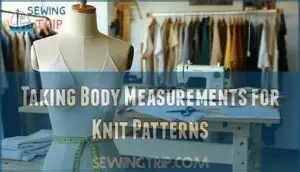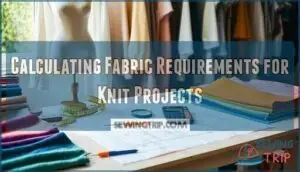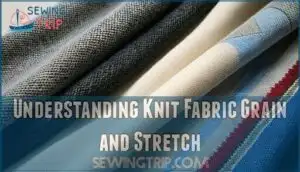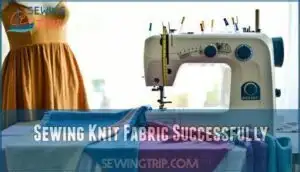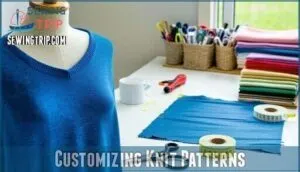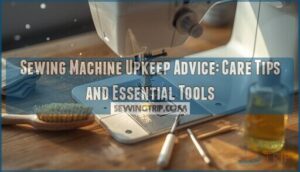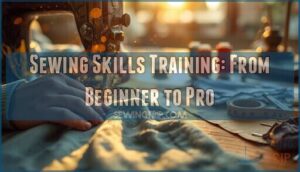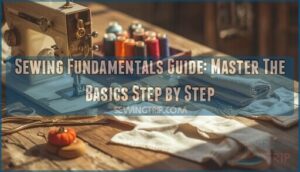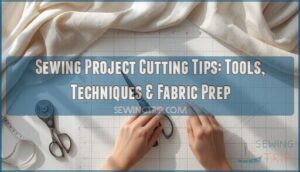This site is supported by our readers. We may earn a commission, at no cost to you, if you purchase through links.
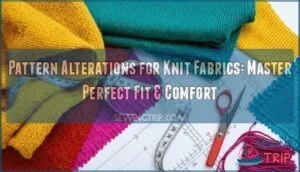
You can’t just grab scissors and wing it like with cotton.
Knits stretch and bounce back, so you’ll need to measure your fabric’s stretch percentage first.
Here’s the game-changer: reduce pattern ease by 25-50% depending on your knit’s stretch.
Think of it like buying jeans – you want them snug because they’ll give.
Test your alterations on scraps first because knits can be sneaky little rebels.
The secret sauce involves understanding negative ease and choosing stitches that move with your fabric.
There’s actually a foolproof formula that makes knit alterations surprisingly simple.
Table Of Contents
Key Takeaways
- Measure your knit fabric’s stretch percentage first – You’ll need to reduce pattern ease by 25-50% depending on how much your fabric stretches, since knits behave differently than woven fabrics and require negative ease for a proper fit.
- Test alterations on fabric scraps before cutting your main fabric – You cannot just wing it with knits like you can with cotton, so always do a test run to avoid costly mistakes and understand how your specific fabric behaves.
- Use the right sewing machine settings and stitches – You’ll need ballpoint or stretch needles, lower presser foot pressure, a longer stitch length, and stretch stitches or a narrow zigzag to prevent broken seams and puckering.
- Grade between pattern sizes strategically – You can combine different sizes at different body points (like a medium bust with large hips) and draw smooth connecting lines to create a custom fit that works with your knit fabric’s stretch properties.
Knit Fabric Basics
You’ll transform your sewing game once you master knit fabrics and their stretchy personalities.
Understanding jersey, ribbing, and ponte knits means you can create clothes that actually fit your body and move with you instead of against you.
Understanding Knit Fabric Types
Knit fabrics come in two main families that’ll make or break your sewing success.
**Master these two knit families and watch your sewing skills soar from amateur to amazing.
Understanding these fabric types transforms your projects from "meh" to magnificent.
Here’s your knit fabric roadmap:
- Weft-knit fabrics (jersey, rib, purl) stretch horizontally with looped yarn construction – perfect for t-shirts and fitted garments
- Warp-knit fabrics (tricot, milanese) resist runs and offer stability – ideal for lingerie and activewear
- Specialty knit fabrics vary in fiber content, weights, and drape properties
Many appreciate knit fabrics because of their fabulous stretch, making them comfortable to wear.
Identifying Fabric Stretch and Recovery
Testing your knit fabric’s stretch and recovery is like checking a rubber band’s bounce-back power!
Pull fabric gently to measure stretch percentage, then release to see how quickly it returns.
Check fiber content labels for spandex or elastane.
Recovery testing reveals if your knit fabrics will keep their shape.
Poor recovery means saggy garments – nobody wants that!
To accurately assess suitability, perform a knit fabric stretch test before cutting.
Choosing Right Knit Fabric for Project
Your stretch percentage knowledge sets you up perfectly for smart fabric selection.
Match your project’s needs with the right knit fabric properties.
Consider fabric weight for structure, fiber content for durability, and drape characteristics for flow.
Check care requirements before buying.
Lightweight jerseys work great for tees, while ponte knits suit structured pieces.
Your fabric selection determines your sewing success.
Pattern Alteration Techniques
Now that you’ve got your knit fabric knowledge down pat, let’s roll up our sleeves and tackle the real magic: altering knit patterns to fit you like a glove!
Dart manipulation is your best friend when working with knits. Unlike woven fabrics, knits stretch and move with you, so traditional darts often aren’t necessary. Instead, you’ll rely on the fabric’s natural give and strategic seaming.
Grading patterns between sizes is a game-changer for knit fabric alterations. Start by combining sizes – maybe you’re a medium in the bust but need a large through the hips. Draw smooth lines connecting the different size lines for a custom fit.
Muslin fitting with knit scraps saves fabric and heartache. The pivoting method works wonders for adjusting shoulder slopes and armholes. Remember, knit sewing adjustments focus more on ease than traditional tailoring techniques. To achieve a perfect fit, compare your body measurements to pattern.
Measuring Knit Fabric
Measuring knit fabric correctly transforms your sewing from frustrating guesswork into exciting success.
You’ll master the sneaky stretchy nature of knits and create clothes that fit like they were made just for you.
Taking Body Measurements for Knit Patterns
Measuring your body for knit fabric alterations requires precision. Start with an Accurate Bust Measurement using a flexible tape.
Check Torso Length Variance by measuring from shoulder to waist. Note your Shoulder Slope Adjustment needs and Armhole Depth Precision.
Add Knit Ease Allowance for comfort. These measurements make knit pattern fitting successful every time.
Calculating Fabric Requirements for Knit Projects
Figuring out fabric needs for knit projects isn’t rocket science, but it’s trickier than woven fabrics.
Start with your pattern’s suggested yardage, then add 10-15% for project allowances and fabric waste.
Consider knit width variations and pattern layout efficiency.
Always do swatch testing first – it’ll save you from that heart-sinking moment when you’re six inches short!
Understanding Knit Fabric Grain and Stretch
Once you’ve nailed your fabric yardage, it’s time to decode how your knit fabrics actually behave. Think of grain direction as your fabric’s GPS – it shows where things stretch and where they stay put.
Here’s your stretch detective checklist:
- Grain Direction – lengthwise grain runs parallel to selvage edges
- Stretch Percentage – crosswise grain typically stretches 25-100% more
- Bias Impact – diagonal cuts create maximum stretch and drape
- Recovery Properties – quality knits snap back after stretching
Understanding grain line considerations is essential for garment fit and drape.
Sewing Knit Fabric Successfully
You’ve got your knit fabric measured and ready – now it’s time to turn that stretchy material into something amazing!
Getting your sewing machine settings right and picking the perfect stitches will transform your knit projects from wonky disasters into professional-looking garments that fit like a dream.
Selecting Right Sewing Machine Settings for Knit Fabric
Your sewing machine needs special attention when working with stretchy fabrics.
Start by lowering your presser foot pressure to prevent fabric from stretching out of shape.
Set your stitch length longer—around 3 or more works great!
Don’t forget proper needle types like ballpoint or stretch needles.
These tension settings and differential feed adjustments make all the difference for perfect knit fabric fitting.
Understanding specific machine features can further improve your sewing results.
Choosing Best Stitch Types for Knit Fabric Seams
Now that your machine’s ready for knit work, selecting the right stitches makes all the difference.
Your seam strength depends on choosing stitches that move with stretch fabrics.
Perfect stitch options for sewing knit fabrics:
- Stretch Stitch – Built-in zigzag motion prevents popping seams
- Serger Options – Four-thread overlock creates professional finish
- Coverstitch Usage – Twin needles produce stretchy, flat seams
These techniques guarantee your altering stretch knits projects stay flexible and durable.
You can find specialized tools for stretch stitch projects online.
Tips for Preventing Knit Fabric Distortion and Curling
Perfect stitches won’t save you if your knit fabric turns into a wavy mess.
Edge stabilization prevents those annoying curled edges – try lightweight interfacing or stay tape.
Keep tension control gentle; tight threads create puckering.
Steam blocking works magic on stubborn distortion.
One method involves serging knit fabric edges for a clean finish.
When sewing knit fabrics, remember: fabric weight matters for successful stretch fabric alterations, and using the right techniques, such as edge stabilization, is crucial.
Customizing Knit Patterns
You’ve mastered the basics of sewing knits, but now it’s time to make those patterns truly yours.
Customizing knit patterns transforms store-bought designs into perfect-fitting garments that show off your unique style and flatter your body like they were made just for you, which is the key to making them truly yours.
Modifying Knit Patterns for Better Fit and Comfort
Getting your knit patterns to fit like they were made just for you isn’t rocket science. Start with muslin fitting to spot knit fit issues before cutting your good fabric.
Most knit garment alterations involve ease adjustments and negative ease tweaks.
Here’s your game plan for perfect knit pattern modification:
- Combine sizes at different body points for custom curves
- Add or subtract ease based on fabric stretch percentage
- Test armhole and neckline adjustments on scraps first
- Mark pattern pieces clearly when making knit fabric adjustments
Adding Design Elements to Knit Patterns
Transform your plain knit patterns into stunning showstoppers with creative design elements!
Colorwork Techniques add vibrant personality while Texture Manipulation creates visual interest through cable motifs.
Embellishment Options like beading sparkle beautifully on stretchy fabrics.
Try Knit Appliqués for playful details or elegant Lace Inserts for romantic touches.
These knitwear design upgrades make basic patterns uniquely yours through thoughtful knit pattern modification.
Troubleshooting Common Knit Pattern Alteration Issues
Even experienced sewists hit snags when working with stretch fabric alterations.
Don’t let common hiccups derail your knit pattern adjustments! Most issues stem from misunderstanding fabric behavior or rushing through fitting steps.
- Fitting Wrinkles – Usually signal tightness around hips, not sway-back problems
- Stretching Issues – Result from improper tension or wrong stitch selection during sewing
- Uneven Hems – Caused by fabric distortion; stabilize before cutting
- Neckline Gaping – Fix by reducing neckline circumference, not shoulder adjustments
- Sleeve Problems – Address armhole fit first before altering sleeve width
To succeed, consider investing in specialized sewing products.
Frequently Asked Questions (FAQs)
How do you tailor knit fabric?
Like ye olde seamstresses who mastered their craft, you’ll need sharp scissors, stretch needles, and ballpoint pins.
Cut with the grain, use zigzag stitches, and always test tension first.
Your knits won’t pucker or lose their stretch!
What stitch is best for knit fabrics?
You’ll want a stretch stitch or narrow zigzag for knit fabrics.
These stitches move with the fabric’s natural stretch, preventing broken threads and puckered seams.
A serger also works wonderfully for professional-looking edges.
What is the best sewing machine setting for knit fabric?
You’ll want a ballpoint needle, slightly lower tension, and a stretch stitch setting.
Don’t forget that walking foot – it’s your secret weapon for preventing puckering and keeping those stretchy fabrics behaving beautifully.
What stitch is best for knit hem?
You’ll want a twin needle for knit hems—it creates two parallel lines of stitching that stretch beautifully with your fabric.
This professional-looking finish prevents puckering and gives you that store-bought appearance every time.
How do vintage knit patterns differ from modern ones?
Vintage knit patterns use less stretch allowance and simpler construction methods.
You’ll find they’re designed for stable knits, not today’s super-stretchy fabrics.
Modern patterns include better ease calculations and advanced techniques.
Can you convert woven patterns to knit patterns?
Converting woven fabric patterns to knit patterns is like translating poetry between languages – you’ll capture the essence but need different techniques.
Yes, you can convert them by adding ease for stretch and adjusting construction methods.
What tools are essential for knit pattern alterations?
You’ll need sharp fabric scissors, measuring tape, pins, seam ripper, and ballpoint needles. Don’t forget stretch rulers and walking foot for your machine. These tools make knit alterations smooth sailing!
How do you grade knit patterns between sizes?
Unlike woven fabrics that stay put, knits stretch and move.
You’ll grade by adjusting both length and width proportionally.
Measure your body, then blend between size lines smoothly.
Don’t forget to test-fit often!
Should you prewash knit fabrics before pattern alterations?
You should definitely prewash your knit fabrics before making pattern alterations.
Knits can shrink or stretch unpredictably, throwing off your carefully planned adjustments.
It’s like measuring twice, cutting once—but for fabric prep, where complete concepts and careful planning are crucial, and knit fabrics require special consideration.
Conclusion
Sure, pattern alterations for knit fabrics might seem tricky at first, but you’ve got this!
You now have the tools to tackle any stretchy fabric challenge.
Remember to test your stretch percentage, reduce that ease, and embrace negative ease like a pro.
Your knits will fit like they were custom-made for you.
No more baggy sweaters or tight t-shirts.
Go grab that jersey fabric and start creating clothes that move with you perfectly!
- https://www.theshapesoffabric.com/2023/11/07/quick-pattern-alterations-with-the-basic-bodice-block-for-knit-fabrics
- https://fitsewbeautiful.com/blog-11/post/113273/5-steps-to-great-fitting-knit-garments
- https://lainepublishing.com/en-us/blogs/journal/5-tips-for-altering-knitting-patterns
- https://www.threadsmagazine.com/forum/converting-knit-patterns-to-wovens
- https://www.mh-chine.com/blog/products/knitted-fabrics

